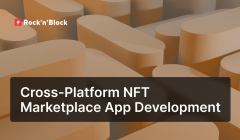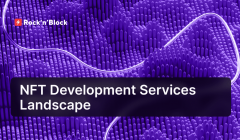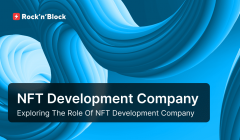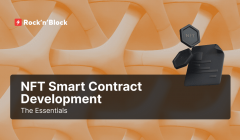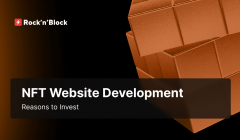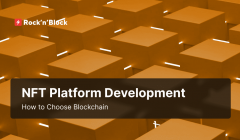Ultimate Guide to NFT Software Development in 2024
03 May 2024In recent years, adoption of NFT software development has transcended the realm of digital art and entered various industries, sparking innovation and reshaping traditional business models. This evolution is driven by the unique capabilities of NFTs to provide verifiable ownership, provenance, and scarcity in the digital domain.
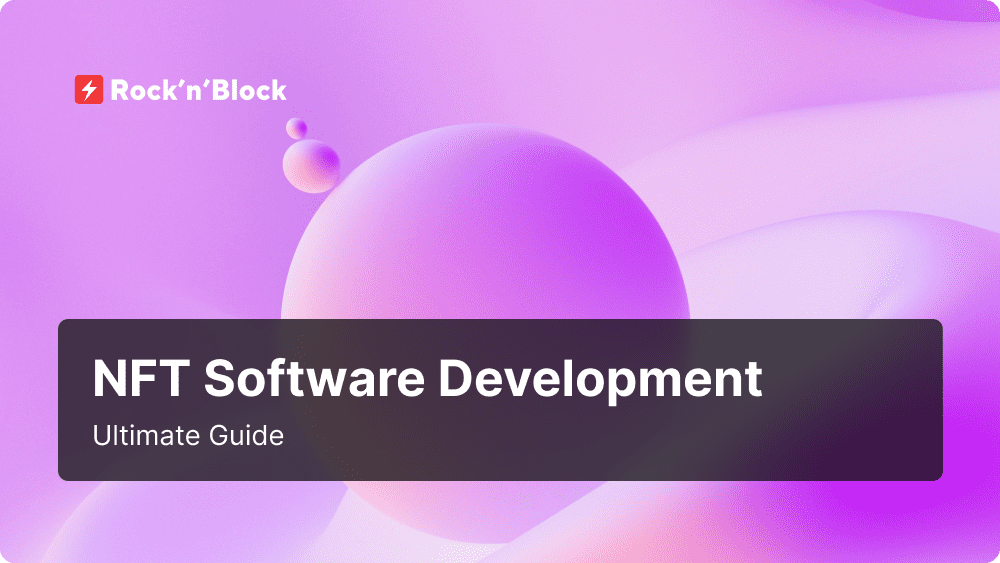
Table of Contents:
-
NFT Software Development Across Industries
-
Ultimate Guide to NFT Software Development
-
Unveiling NFT Types
-
Static NFTs
-
Dynamic NFTs
-
-
Key Components of NFT Software Development
-
NFT Smart Contracts
-
NFT Wallets
-
Frontend Development
-
Backend Components in NFT Software Development
-
-
NFT Software Development Process
-
Step 1. Conceptualization
-
Step 2: Development Stage in NFT Software Development
-
Step 3: Testing and Quality Assurance in NFT Software Development
-
Step 4: Mainnet Deployment Essentials in NFT Software Development
-
-
Conclusion
💼 NFT Software Development Across Industries
Let's explore how NFT software development is making waves across diverse sectors.
Event Ticketing NFT Software
Revolutionizing the way events are managed and tickets are distributed, event ticketing NFT software employs blockchain technology to create unique, non-fungible tokens for each ticket. These digital assets ensure secure and transparent ticket transactions, eliminating issues such as counterfeiting and scalping. With this software, event organizers can streamline ticket sales, verify ownership, and facilitate secondary market transactions seamlessly, offering a new level of trust and authenticity to event-goers.
Tokenized Real Estate
Transforming the traditional real estate market, tokenized real estate NFT software digitizes property ownership through blockchain-based NFTs. Each property is represented by a unique digital token, enabling fractional ownership, transparent transactions, and liquidity in real estate assets. Investors can easily buy, sell, or trade property tokens, unlocking opportunities for diversified portfolios and democratizing access to real estate investment. Additionally, this software facilitates transparent record-keeping, reducing administrative burdens and ensuring compliance with regulatory standards.
NFT Games
NFT software development has transcended the virtual realm, allowing gamers to truly own and trade in-game assets. Blockchain integration plays a vital role in NFT Gaming platforms development, transitioning in-game assets into valuable digital commodities. NFT-based game items, characters, and skins can be owned, traded, and utilized across different gaming ecosystems. NFT software development enables seamless integration, fostering a decentralized and player-centric gaming experience.
Fashion and Luxury Goods
NFTs have provided a novel canvas for fashion designers and artists. Leading fashion brands are exploring NFTs to authenticate and tokenize limited-edition collections. NFT software development allows brands to create digital certificates of authenticity, ensuring the scarcity and uniqueness of high-end fashion items. This not only combats counterfeiting but also opens new avenues for brand-consumer interaction.
Web3 Identification
Empowering users with decentralized identity solutions, Web3 Identification integrated with NFT software ensures secure and privacy-preserving authentication and verification processes. By utilizing blockchain technology, individuals can create self-sovereign identities represented as NFTs, allowing them to control their digital identities and personal data. This innovative approach to identification enhances security, reduces identity theft risks, and enables seamless access to various online services and platforms.
Education
Innovating the educational landscape, education NFT software leverages blockchain technology to authenticate and track academic credentials, certifications, and achievements as non-fungible tokens. By digitizing records securely on the blockchain, this software enhances the integrity and portability of educational credentials, simplifying verification processes for employers, academic institutions, and learners. Additionally, education NFT software facilitates the creation of unique learning experiences, where NFTs represent access to exclusive content, courses, or virtual mentorship programs, fostering a more personalized and incentivized approach to education.
Ultimate Guide to NFT Software Development
As the demand for NFTs continues to surge, the need for robust, scalable, and customizable NFT solutions becomes paramount. NFT Software Development is the key to bringing NFT visions to life, offering tailored platforms, protocols, and NFT marketplaces development that cater to the specific requirements of creators, collectors, and innovators in the NFT ecosystem.
🧩 Unveiling Diverse NFT Types
As NFT software development continues to redefine the digital landscape, understanding the intricacies of different NFT types is paramount. This section explores the two primary types: Static NFTs and Dynamic NFTs, each offering distinct characteristics and functionalities within the NFT development use cases.
Static NFTs Defined
Static NFTs represent a foundational concept in NFT software development, encompassing digital assets with fixed and unchangeable attributes. These assets, often associated with art projects and digital collectibles, are minted on the blockchain with metadata that remains constant over time.
Key Characteristics of Static NFTs
-
Immutability: The defining trait of static NFTs is their immutability. Once minted, the metadata attached to these tokens remains unmodifiable, ensuring a secure and tamper-resistant representation of digital assets.
How Static NFTs Work
Static NFTs operate on blockchain standards such as ERC-721 or ERC-1155, providing a secure and transparent ledger for ownership. The metadata associated with these tokens, including descriptions, images, and other attributes, is embedded within the token during the minting process.
Dynamic NFTs in NFT Software Development
Dynamic NFTs, or dNFTs, mark an evolution within NFT software development by introducing interactive and adaptable elements to digital assets. Unlike their static counterparts, dynamic NFTs can evolve over time, responding to external conditions and incorporating real-time data.
Key Characteristics of Dynamic NFTs
-
Adaptability: Dynamic NFTs showcase adaptability, with changes that occur in their metadata based on predefined conditions. This versatility opens the door to a myriad of applications, from real-time data updates to interactive gaming experiences.
-
Smart Contracts and Oracles: The key components driving dynamic NFTs include smart contracts and oracles. Smart contracts facilitate execution of predefined instructions, while oracles provide external data necessary for dynamic changes.
How Dynamic NFTs Work
Dynamic NFT development leverages smart contracts to encode automatic changes within the NFT when triggered by specific conditions. Oracles play a crucial role by facilitating the integration of real-time data into the NFT, ensuring responsiveness to a dynamic environment.
To create dynamic NFTs, several steps are involved, including setting up ERC-721 or ERC-1155 tokens, uploading image links in IPFS URIs, performing compile checks, ensuring "Keepers Compatibility," and creating smart contracts that modify NFTs based on specified variables. Platforms and tools like Chainlink VRF, Chainlink Keepers, Polygon, Truffle, Hardhat, and MetaMask are instrumental in this process.
Static NFTs vs. Dynamic NFTs
-
Immutability vs. Interactivity: Static NFTs prioritize immutability, ensuring a secure and unchanging representation of digital assets. In contrast, dynamic NFTs embrace interactivity with the updates and changes based on external conditions.
-
Use Cases: Static NFTs find their stronghold in preserving the authenticity of digital art and collectibles. Dynamic NFTs, with their ability to adapt, are well-suited for applications like real-world asset tokenization and interactive gaming experiences.
Understanding the nuances between static and dynamic NFTs within the context of NFT software development empowers NFT projects founders to make informed choices based on their specific needs and objectives. Whether seeking security and permanence or interactivity and adaptability, these NFT types offer a diverse toolkit for shaping the future of digital ownership.
👀 Key Components of NFT Software Development
NFT Smart Contracts
At the core of NFT Software Development, smart contracts act as self-executing agreements defining the rules for NFT creation, ownership, and transfer.
Token Standards in NFT Software Development
Token standards, such as ERC-721 and ERC-1155, play a pivotal role in shaping NFT ecosystem
Decoding ERC721 Token Standard
Within the context of NFT software development, ERC-721 stands as an open standard, offering a predefined interface that establishes rules governing interactions with NFT assets. It is essential to recognize that while ERC-721 tokens are a prevalent type of NFT, other standards, such as ERC-1155 tokens, also contribute to the diverse NFT ecosystem.
Key Functions and Events in ERC-721 for NFT Software Development:
-
balanceOf: In the realm of NFT software development, the balanceOf function is crucial. It returns the number of NFTs owned by a specific address, providing developers with essential information for managing user portfolios.
-
ownerOf: NFT software development relies on the ownerOf function to retrieve the address of the owner of a specific token, identified by its unique ID. This function enables developers to ensure accurate ownership tracking.
-
safeTransferFrom (without data): Within the context of NFT software development, the safeTransferFrom function plays a key role in securely transferring ownership of a token between addresses. Its implementation includes checks to verify whether the recipient address is a smart contract.
-
transferFrom: For NFT software developers, the transferFrom function is instrumental in transferring ownership of a token from one address to another. This is particularly useful when the sender has obtained prior approval for the transfer.
-
approve: NFT software development leverages the approve function to grant approval to a specific address for the transfer of a designated token. This facilitates delegated transfers, a feature often integrated into NFT-based applications.
-
getApproved: In NFT software development workflows, the getApproved function serves to retrieve the approved address for a specific token, contributing to transparency in the token approval process.
-
setApprovalForAll: Within the spectrum of NFT software development, the setApprovalForAll function allows an owner to approve or revoke approval for an operator to manage all of their tokens. This functionality enhances control and flexibility in token management.
-
isApprovedForAll: NFT applications benefit from the isApprovedForAll function, which checks whether an operator is approved to manage all tokens owned by a specific address. This verification is essential for secure and authorized token operations.
ERC-1155 Standard Explained
Within the realm of NFT software development, the ERC-1155 standard plays a pivotal role as a multi-token standard, offering a unified solution for the creation of fungible, non-fungible, and semi-fungible tokens within a single smart contract. This standardization significantly streamlines the development process, providing efficiency gains and minimizing transaction count, crucial aspects in the context of NFT software development where optimizing blockchain resources is paramount.
Key Features and Applications in NFT Software Development:
-
Fungible and Non-Fungible Tokens: As an integral component of NFT software development, ERC-1155 accommodates both fungible and non-fungible tokens. This versatility allows developers to handle various token types seamlessly within a single contract, catering to the diverse requirements of NFT applications.
-
Efficiency and Reduced Transaction Count: NFT software development projects benefit from ERC-1155's capability to launch multiple NFT collections in a single smart contract. This not only enhances the efficiency of smart contract construction but also reduces the overall transaction count. In the competitive landscape of NFT platforms, this optimization is crucial for cost-effectiveness and sustainable blockchain usage.
-
Batch Transfer Capability: The ERC-1155 standard introduces the capability for batch transfers of tokens, a feature of particular significance in NFT software development scenarios requiring simultaneous transfers of multiple tokens to different addresses. This enhances the user experience and streamlines transaction workflows within NFT applications.
-
Applications in Decentralized Games: NFT software development, especially in the context of creating decentralized games, benefits from ERC-1155's ability to manage both in-game coins (fungible) and collectibles (non-fungible). Its widespread adoption in blockchain-based P2E games showcases its effectiveness in meeting the unique demands of NFT software development projects.
-
Complex Mapping for Flexibility: Unlike traditional mapping in ERC-721, where there's a one-to-one correspondence between token IDs and addresses, ERC-1155 employs a more intricate mapping. The combination of token ID and address is mapped to the balance of the token, providing NFT software developers with increased flexibility in token management.
📄 Protocol-Specific Smart Contracts in NFT Software Development
Protocol-specific contracts cater to diverse use cases, enhancing the overall dynamics of the NFT ecosystem. Here's an exploration of key protocol-specific smart contracts that contribute to the evolution of NFT software development:
Buy/Sell/Auction Contracts:
Serving as core components of NFT marketplaces, these contracts streamline non-fungible tokens trading. These contracts encompass features that facilitate NFTs listings for sale, executing purchases, and conducting auctions, creating a dynamic environment for buyers and sellers.
NFT Factory Contracts:
NFT factory contracts play a crucial role in expediting the creation and deployment of new NFTs. In the context of NFT software development, they act as templates for generating new tokens, allowing developers to efficiently create diverse collections with predefined attributes. This accelerates the NFT creation process, particularly beneficial for large-scale projects.
Fractionalization Contracts:
Revolutionizing NFT ownership, fractionalization contracts enable the division of NFTs into smaller, tradable shares. Tailored for NFT software development, these contracts foster investment opportunities and shared ownership, making high-value NFTs more accessible. They often include features for voting and governance among fractional owners.
NFT Staking Contracts
NFT staking smart contracts revolutionize blockchain ecosystems, enabling users to stake their Non-Fungible Tokens (NFTs) for rewards. Applications span gaming platforms, content creation platforms, DAOs, and web3 social networks, rewarding engagement and creativity. In virtual worlds and metaverse projects, NFT staking simulates ownership, offering users privileges and benefits. The adaptability of NFT staking smart contracts facilitates innovative applications across diverse sectors within the blockchain space.
Governance Contracts:
Tailored for NFT software development, governance contracts empower NFT communities to collectively decide on the management and evolution of their ecosystem. Through decentralized voting mechanisms, community members within the NFT software development space can propose and vote on changes to protocols, upgrades, or other crucial decisions, ensuring a democratic and participatory NFT environment.
Escrow Contracts:
In NFT software development, escrow contracts play a vital role in facilitating secure transactions. These contracts hold NFTs or funds in escrow until predefined conditions are met, adding an extra layer of trust to NFT transactions. They are particularly valuable in high-value or complex transactions within the NFT software development space.
The realm of NFT Software Development is marked by constant innovation, giving rise to a multitude of specialized contracts tailored for unique project mechanics and business logic. The dynamic nature of the space continually introduces novel contract types that cater to specific project needs and industry trends. NFT project developers and founders should maintain a proactive approach in staying informed about emerging contract innovations to best suit the evolving landscape of their projects.
🔓 The Role of IPFS and Metadata in NFT Software Development
In NFT software development, IPFS (InterPlanetary File System) and metadata play crucial roles in enhancing the functionality, decentralization, and user experience associated with non-fungible tokens (NFTs).
1. IPFS (InterPlanetary File System):
-
Decentralized Storage: IPFS provides a decentralized and distributed file storage system. In the context of NFTs, this means that the associated media files, such as images, videos, or 3D models, can be stored in a decentralized manner across multiple nodes rather than relying on a central server. This decentralization ensures that the files remain accessible even if one or more nodes go offline.
-
Immutable File Storage: Files on IPFS are addressed using content-based addressing, which means the content itself determines the address. This immutability ensures that the content linked to an NFT remains unchanged over time, preserving the integrity of the digital asset.
-
Efficient Content Delivery: IPFS enables efficient and distributed content delivery. When a user accesses an NFT, the associated media files can be fetched from the nearest or most available IPFS node, reducing latency and improving overall performance.
2. Metadata
-
Descriptive Information: Metadata in the context of In NFT software development refers to additional information associated with the NFT token, such as title, description, creator details, and attributes. This metadata provides descriptive information about the NFT, enhancing its context and value.
-
Interoperability: Metadata follows specific standards like JSON (JavaScript Object Notation) and is often embedded in the NFT smart contract. This standardization ensures interoperability across various platforms, wallets, and marketplaces, allowing NFTs to be easily recognized and displayed consistently.
-
Customization and Uniqueness: Metadata enables customization of NFT attributes, making each token unique. This could include details such as edition number, creation date, or any other relevant information that adds to the uniqueness and scarcity of the NFT.
-
Rich Experiences: Metadata enriches the user experience by providing more than just the visual representation of the NFT. It allows creators to tell a story, provide context, or share additional multimedia content related to the digital asset.
In summary, IPFS and metadata are integral components in NFT software development. IPFS ensures decentralized and immutable storage of media files, while metadata enhances the token's descriptive information, uniqueness, and overall user experience. Together, they contribute to the robustness, decentralization, and richness of the NFT ecosystem.
👛 NFT Wallets
Custodial Wallets
Custodial wallets hold NFTs within a specific project ecosystem. These wallets are employed when NFTs are used exclusively within a particular protocol or project. They offer simplicity and ease of use but limit user control.
Non-Custodial Wallets:
Non-custodial wallets provide users with higher control and are suitable for scenarios where NFTs traverse various protocols. Users retain ownership and can manage their NFTs across different projects, offering greater flexibility.
💻 Frontend development
In NFT software development, frontend components play a vital role in creating a robust, user-friendly, and visually appealing interface for interacting with blockchain-based assets and functionalities.
Layouting and Fluid Responsive Design
-
Grid Systems and Flexbox
Grid systems and Flexbox provide a flexible and grid-based layout structure, allowing frontend to adapt to different screen sizes and orientations. This ensures a consistent and visually appealing NFT software UI across devices.
-
Media Queries
Media queries enable the frontend to apply different styles based on factors such as screen width, resolution, and device type. This ensures a responsive design that adjusts seamlessly to varying device specifications.
-
Responsive Images
Responsive images implementations, such as using the ‘srcset’ attribute, allow the frontend to serve appropriately sized images based on the user's device. This optimizes page loading times and improves overall performance.
Wallet Integration
-
Wallet Connectivity
Wallet connectivity ensures that the frontend communicates effectively with users' wallets, enabling functionalities like creating new accounts, displaying real-time balances, and managing transactions securely.
-
Wallet Balances
The frontend retrieves and displays wallet balances, providing users with an accurate and up-to-date overview of their cryptocurrency holdings and NFT assets.
Smart Contract Interaction
-
Smart Contract Abstraction Libraries
Abstraction libraries simplify smart contract interactions by providing high-level functions. This allows the frontend to interact with smart contracts without dealing with low-level details, enhancing development efficiency.
-
User-Friendly Interfaces
User-friendly interfaces provide an intuitive way for users to engage with smart contracts, facilitating actions such as minting NFTs, transferring ownership, or participating in auctions directly from the frontend.
User Authentication
-
Secure Login
Secure login processes ensure that user accounts are protected. Multi-factor authentication adds an additional layer of security, requiring users to provide multiple forms of verification for account access.
Integration with Blockchain APIs:
-
Node Connection
Node connection and data retrieval from blockchain APIs enable the frontend to fetch and display real-time data, ensuring that users have accurate information about transactions, account details, and NFT metadata.
-
Data Retrieval
Data retrieval tools ensure that the frontend reflects the most recent blockchain data, providing users with a real-time and accurate representation of their NFT-related activities.
Real-Time Updates
-
WebSocket Integration
WebSockets facilitate bidirectional communication, allowing the frontend to receive instant updates on transaction statuses, wallet balances, and relevant NFT events.
-
Event Handling
Event handling ensures that the frontend is responsive to blockchain events, dynamically updating the user interface to reflect changes such as successful transactions, new NFT listings, or updated wallet balances.
User Assistance
-
Input Validation
Input validation on the frontend ensures that user inputs meet required criteria, providing immediate feedback to users and preventing errors during form submissions.
-
Error Notifications
Error notifications communicate issues clearly to users, offering guidance on how to address errors and ensuring a smooth and user-friendly experience.
-
Loading Indicators
Loading indicators inform users that an action, such as a transaction or data retrieval, is in progress, reducing uncertainty and providing feedback on ongoing activities.
Animations
-
Subtle Transitions
Subtle transitions contribute to a smoother user experience, enhancing the visual appeal of the NFT platform without overwhelming users with excessive animation.
-
Feedback Animations
Feedback animations offer visual cues, confirming successful actions and providing a more engaging and responsive experience for users.
-
Loading Animations
Loading animations provide a visual indication that the system is actively processing data, keeping users informed and engaged during potentially longer waiting periods.
In NFT software development, the frontend is not only about visual appeal but also about creating a smooth, secure, and responsive environment for users to interact with blockchain-powered functionalities and digital assets.
⚙️ Backend Components in NFT Software Development
In the realm of NFT software development, the backend infrastructure plays a pivotal role in supporting the creation, management, and interaction with NFTs on the blockchain. NFT software development involves a unique set of backend components that seamlessly integrate with the decentralized nature of blockchain networks. Here's a breakdown of key backend components within the context of NFT software development:
Web Server for NFT Software Development:
In NFT software development, the web server remains essential for handling incoming HTTP requests from clients, such as web browsers or mobile apps. It facilitates the initial connection and serves static assets, ensuring a smooth user experience while interacting with NFT platforms.
Application Server for NFT Software Development:
The application server in NFT software development executes server-side code, managing business logic, and facilitating interactions with the blockchain. It becomes the backbone for processing NFT-related operations, including minting, transferring, and querying NFTs on the blockchain.
Database Management System (DBMS) in NFT Software Development:
While blockchain serves as the decentralized ledger for NFTs, traditional databases (relational or NoSQL) within the backend of NFT software development might be utilized for efficient storage and retrieval of non-sensitive information. This could include metadata associated with NFTs or user-related data.
API Integration in NFT Software Development:
APIs play a crucial role in connecting the backend of NFT software with various components, such as blockchain nodes, decentralized storage, oracles, and external services. They facilitate seamless communication, enabling the NFT platform to retrieve and display relevant information to users.
Server-Side Scripting for NFT Software Development:
Server-side scripting languages like PHP, Python, or Node.js are employed in NFT software development to implement logic on the server. These scripts generate dynamic content and handle backend processes, ensuring the efficient execution of NFT-related functionalities.
Authentication and Authorization in NFT Software Development:
Security remains paramount in NFT software development. Backend components manage user authentication and authorization processes, verifying user identities securely. Decentralized identity solutions may be integrated, ensuring the authenticity of NFT transactions.
Middleware for NFT Software Development:
Middleware components in NFT software development handle various tasks, including request processing and data transformation. They enhance functionality and communication between the application server and the web server, ensuring a seamless flow of data within the NFT platform.
Caching Strategies for NFT Software Development:
Implementing caching mechanisms in the backend optimizes performance by temporarily storing frequently accessed data. In NFT software development, this could include caching metadata or token information, reducing the load on the blockchain network and enhancing user experience.
Logging and Monitoring in NFT Software Development:
Backend components include logging mechanisms and monitoring tools to record events, errors, and transactions. In the context of NFT software development, monitoring extends to tracking blockchain transactions, ensuring the reliability and health of the NFT platform.
Background Processing for NFT Software Development:
Background processing components, such as message queues or task schedulers, handle time-consuming tasks efficiently. In NFT software development, they could manage asynchronous processes, such as updating NFT metadata or handling complex transactions in the background.
Blockchain Nodes in NFT Software Development:
The backend interacts with a blockchain node to read and write data to the blockchain. In NFT software development, the connection with the blockchain node is central to performing operations like minting NFTs, transferring ownership, and querying blockchain data related to NFTs.
Blockchain APIs and Web3 Library in NFT Software Development:
NFT software development often involves integration with external blockchain APIs and utilizing Web3 libraries like Web3.js for Ethereum. These components enable seamless communication with blockchain nodes, facilitating interactions with smart contracts and ensuring the proper functioning of NFT-related operations.
Decentralized Storage and Oracles in NFT Software Development:
DApps may utilize decentralized storage solutions like IPFS for storing and retrieving NFT-related files. Additionally, oracles may provide external data to smart contracts. The backend in NFT software development interacts with these services to manage data storage, retrieval, and integration of real-world data into the NFT ecosystem.
Blockchain Scanners and Event Handling for NFT Software Development:
Smart contracts emit events when specific actions occur, such as the creation or transfer of NFTs. The backend, through blockchain scanners and event handling mechanisms, listens for these events to trigger actions or update the frontend in real-time, ensuring a dynamic and responsive NFT platform.
In conclusion, the backend components in NFT software development form a sophisticated infrastructure that harmonizes traditional web development principles with the unique requirements of blockchain technology. This seamless integration enables the creation and management of NFTs in a secure, efficient, and user-friendly manner on decentralized platforms.
🛠️ NFT Software Development Process
In the fast-evolving landscape of NFT Software Development, the process of bringing NFT projects to life is as intricate as the tokens themselves. NFT Software developers and founders play a pivotal role in navigating this journey, ensuring the creation of robust, secure, and innovative NFT solutions. Let's delve into the key stages of the NFT Software Development Process, where creativity meets technology.
💡 Step 1. Conceptualization
The journey into NFT software development begins with a critical phase: Conceptualization. This initial step sets the stage for the entire development process, shaping the vision and defining the fundamental parameters of the NFT project. Let's delve into the key components of the first step.
1.1 Vision Casting
At the heart of NFT software development lies a clear and compelling vision. Founders of NFT projects come together to articulate the purpose, use cases, and unique selling propositions that will characterize their NFT ecosystem. This collaborative effort involves defining the target audience, identifying potential industry applications, and establishing overarching goals for the project. A well-defined vision serves as the guiding light throughout the development process, ensuring that every subsequent decision aligns with the project's core objectives.
1.2 Market Research
Understanding the competitive landscape and staying abreast of market trends is paramount in the fast-evolving world of NFTs. Comprehensive market research is conducted to identify gaps, potential challenges, and innovative features that can distinguish the NFT project from others. This phase allows developers to refine their strategies, foresee challenges, and adapt to emerging trends, ultimately increasing the project's chances of success in a dynamic and competitive market.
1.3 Project Business Requirements Definition
In this stage, the foundational aspects of the NFT project are outlined. Business requirements are defined, outlining the functional and non-functional needs of the system. This includes a detailed understanding of user interactions, business processes, and overall project goals. Clarity at this stage lays the groundwork for a streamlined development process.
1.4 Project Technical Requirements Definition and Tech Spec Development
Hand-in-hand with business requirements, technical specifications are formulated. Bridging the conceptual and technical realms, the transition from business logic to technical implementation takes place. The high-level vision is translated into actionable steps, mapping out how the NFT software will function in practice. This step involves breaking down complex concepts into modular components, ensuring a systematic approach to development. Outlining the technical aspects of the NFT software, including the choice of blockchain, technology stack, requirements to smart contracts, backend, frontend, API endpoints, external tools and frameworks, services and technology used. A detailed technical specification document is developed, serving as a roadmap for the development team to follow during the implementation phase.
1.5 White Paper Design
As the foundational documentation for the NFT project, the white paper is designed to articulate the vision, technical details, and business model of the project. It serves as a comprehensive guide for stakeholders, investors, and the broader community, providing transparency and clarity about the project's goals and implementation.
🧑💻 Step 2: Development Stage in NFT Software Development
In navigating the Development Stage of NFT software creation, adept project management is paramount for a cohesive and triumphant journey. Let's explore how effective project management principles can be seamlessly woven into this intricate process:
Agile Methodology in NFT Software Development:
Agile, with its emphasis on adaptability, collaboration, and iterative progress, seamlessly aligns with the dynamic landscape of blockchain. This agile approach enables the team to respond adeptly to evolving challenges and changing requirements. By encouraging constant reassessment and refinement, Agile ensures a resilient and adaptive development journey.
In the realm of NFT software development, the advantages of Agile over traditional methodologies like Waterfall become pronounced. Agile's flexibility, collaborative nature, and incremental deliverables stand in stark contrast to the rigidity of Waterfall. Regular client feedback, early issue identification, and rapid adaptability to changes make Agile a client-centric and responsive choice for the unpredictable nature of blockchain projects.
Smart Contract Development:
Smart Contract Development, a pivotal aspect of NFT software creation, requires meticulous attention guided by effective project management. Crafting token smart contracts, adhering to standards, and custom contract creation and unit tests development demand a well-managed effort. Project managers ensure that Smart Contract Development seamlessly aligns with overarching project goals, meeting specific requirements and laying the robust groundwork for the NFT ecosystem.
Frontend Development
Frontend Development employs creation of an intuitive, visually appealing, and responsive interface that executes frontend logic based on the business and technical requirements. Collaboration with UI/UX designers, clear technical specifications and project management are vital elements in the process.
Backend Development
From data management and API integration to security measures and blockchain node interaction, backend developers ensure the establishment of a solid foundation. Effective coordination with frontend and smart contract development teams is pivotal in creating a backend that robustly supports the functionality, security, and efficiency of the entire NFT platform.
🕵️ Step 3: Testing and Quality Assurance in NFT Software Development
The testing and quality assurance phase in NFT software development is a crucial step dedicated to ensuring the reliability, security, and optimal performance of the NFT platform. This stage involves comprehensive testing methodologies and quality assurance processes to identify and address potential issues before the platform is deployed for public use:
Integration Testing
Verify the seamless integration of different modules within the NFT platform. Integration tests help identify and resolve issues that may arise when components interact with each other.
End-to-End Testing:
Perform end-to-end tests to simulate real user scenarios and validate the complete flow of the NFT platform. This ensures that all components work together cohesively, from user interaction to backend processes.
Security Testing:
Conduct thorough security assessments to identify vulnerabilities and weaknesses in the system. This includes penetration testing, code reviews, and ensuring secure communication between the frontend and backend.
Performance Testing:
Evaluate the scalability and responsiveness of the NFT platform under different load conditions. Performance testing helps identify bottlenecks, optimize resource utilization, and ensure a smooth user experience even during peak usage.
Usability Testing:
Assess the user interface for intuitiveness and user-friendliness. Usability testing ensures that the frontend design aligns with user expectations, providing a positive and engaging experience.
Compatibility Testing:
Verify the NFT platform compatibility across various devices, browsers, and operating systems. Compatibility testing ensures a consistent user experience regardless of the user's preferred environment.
Regression Testing:
Conduct regression tests to ensure that new developments or bug fixes do not negatively impact existing functionalities. This helps maintain the stability of the NFT platform throughout its development lifecycle.
Security Audits:
Conduct rigorous security audits specific to the mainnet environment. Collaborate with security experts to identify and address vulnerabilities, ensuring the resilience of the NFT platform against potential threats.
The testing and quality assurance phase is integral to delivering a reliable and secure NFT platform. Rigorous testing practices help identify and resolve potential issues, ensuring that the platform meets high-quality standards and provides a positive user experience in the dynamic landscape of NFT software development.
✨ Step 4: Mainnet Deployment Essentials in NFT Software Development
Mainnet deployment in NFT software development is a critical transition that demands meticulous planning and execution. Here are five vital points to ensure a successful and secure deployment on the live production network:
Smart Contract Deployment:
Verify and deploy thoroughly tested smart contracts to the mainnet. Confirm the integrity and functionality of these contracts, ensuring they align with the predetermined rules and constraints for NFT operations.
Monitoring and Logging Setup:
Establish a robust system for monitoring and logging on the mainnet. Configure real-time tracking, alerts for potential issues, and detailed logging mechanisms to facilitate post-deployment analysis and timely response.
User Communication and Onboarding:
Communicate effectively with users and stakeholders about the mainnet deployment. Provide clear instructions, updates, and user guidance. Facilitate a smooth onboarding process and establish responsive support to address user queries during the transition.
Continuous Monitoring and Optimization:
Implement continuous monitoring tools for the mainnet to track performance and user interactions. Optimize configurations and address emerging issues promptly to maintain a stable, efficient, and user-friendly NFT platform.
These key considerations ensure a successful mainnet deployment, setting the stage for the NFT platform to thrive in the live production environment.
Summing up NFT software development process
As we conclude the development stages of building NFT software, it's crucial to recognize that the journey extends beyond the technical intricacies. While achieving a robust backend, a user-friendly frontend, and successfully deploying on the mainnet are significant milestones, the success of an NFT platform is equally dependent on effective marketing, user engagement, acquisition, and retention strategies. Initiating these efforts ensures that the platform gains visibility in the competitive landscape of decentralized applications. User-centric approaches, community building, and strategic marketing endeavors play a pivotal role in attracting, retaining, and fostering an active user base.
Conclusion
In conclusion, the landscape of NFT software development is both promising and complex, presenting myriad opportunities for innovation. Despite the intricacies, new use cases continue to emerge, opening doors for novel applications in the market.
Rock'n'Block - NFT development company, is committed to navigating this dynamic space, offering expertise and support with diverse NFT development services to ensure success in the evolving world of NFTs. Let's seize the opportunities, overcome challenges, and shape the future of NFT software development together.
We ❤️ Development
Follow us on social media to receive the hottest blockchain development updates
Twitter ⚡️Telegram⚡️LinkedIn⚡️Facebook
